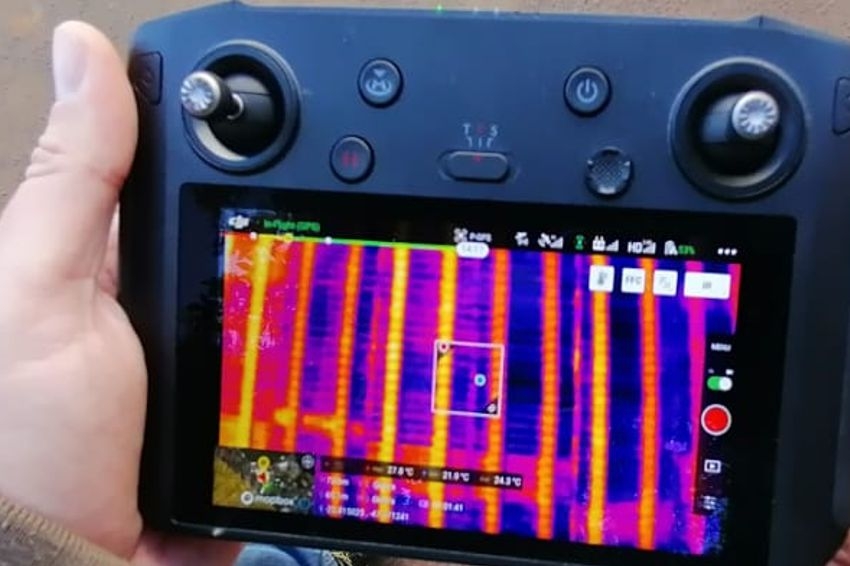Thermography is a well-known ally in detecting faults in electrical installations. In photovoltaic plants, the technique can also be used to evaluate solar panels.
It must be carried out during commissioning and routine operation and maintenance (O&M) interventions of photovoltaic plants.
Thermography is the name we give to the process of obtaining images using a camera equipped with an infrared radiation sensor.
Infrared is the part of the spectrum of electromagnetic radiation associated with the transmission of heat. When we obtain an infrared image, we are in practice seeing the amount of heat emitted by bodies.
The intensity of the infrared light radiated by an object makes it possible to identify its temperature. This powerful tool is useful for mapping the temperature of objects, allowing you to greatly expand the perception of failures in photovoltaic and electrical systems in general.
Specific temperature rises in photovoltaic modules are, in general, an indication of damage or manufacturing defects.
Occurrences of this type must be detected at the beginning of the plant's operation, in the hot commissioning stage (when the plant or part of it is put into operation while still in the testing phase) and also in operation and maintenance actions that must be carried out periodically at the same time. throughout the life of the system.
Infrared cameras are available on the market in a wide range of models and features. What generally differentiates one piece of equipment from another is its graphic resolution, its thermal sensitivity and its technological resources, such as the possibility of superimposing different layers of images and configuring color maps, among other things.
A high-resolution camera can allow simultaneous inspection of large areas, while a lower resolution requires greater attention to individual objects, which complicates the thermographic analysis process in large systems.
When it comes to solar plants – on the ground or on roofs – with more than a hundred modules, it is important to use aerial thermography, which can be carried out using a drone equipped with a thermographic camera.
Drones have become essential equipment in the maintenance of photovoltaic plants. Fortunately, this equipment is increasingly accessible and there are very sophisticated models within the reach of professionals and small businesses.
The drones available on the market have technological resources that allow overflights with programmed routes over photovoltaic plants, making the thermal inspection process very agile.
Drones are already supplied by the manufacturer in specific versions for carrying out thermography, and it is not necessary (nor recommended) to make adaptations to equipment for conventional images.
Problems that can be detected
The purpose of aerial thermography is the inspection of the solar panels of the photovoltaic plant. Inspection of cables and electrical connections must be carried out using terrestrial thermography, with manual cameras.
The most common defects found in photovoltaic modules are:
- Broken or cracked cells during transport or installation;
- Broken glass during the vegetation cutting process or during cleaning;
- Cell detachment due to lamination failure (manufacturing process);
- Moisture penetration generally caused by defects in the back plastic sheet (backsheet) of the module;
- Defects in electrical connections and defects in junction box diodes.
The presence of thermal anomalies perceived in the form of hot spots (hotspots) may indicate the existence of one of these defects.
Identification of defective modules is important to avoid problems with plant performance and safety. Modules with very hot cells can become sources of fire.
Even in situations that do not evolve into fire cases, defects cause a reduction in performance and limit the useful life of the system.
Table 1: Some anomalies that can be noticed by thermographic inspection of photovoltaic modules. Source: adapted from Testo Thermography Guide
Case Study
On-ground minigeneration plant
The images below were captured with a DJI Mavic 2 Enterprise Dual drone, equipped with a conventional camera and an infrared camera.
In this case, no anomalies were detected in the photovoltaic modules. Thermographic images indicated surfaces with uniformly distributed temperatures, without points of high thermal concentration (hotspots).




Experimental plant on ground
In the case shown below, overheating points caused by the presence of a shadow were detected.
The presence of shadows or dirt can distort the results of the thermographic inspection. It is important that the modules are clean and operating under uniform solar irradiation conditions.

Roof photovoltaic systems

The following figure shows images that reveal a rooftop photovoltaic system free of thermal abnormalities. The diagnosis was later confirmed with closer images.
On the other hand, the following figure shows a photovoltaic system, also on a roof, in which a defect was detected in one of the modules.
The problem went unnoticed in electrical tests. There is no visible dirt or damage to the panel, indicating a possible manufacturing defect.

Care during thermographic inspection
There are many details to the science of thermography. Accurately determining the temperature of a point depends on the emissivity of the surface being inspected, the distance and angle at which the camera is positioned, among other things.
However, within the scope of inspection of photovoltaic plants, what is sought is not the exact determination of surface temperatures, but rather the identification of temperature patterns that may reveal abnormalities.
A professional properly trained in handling a drone, even without advanced knowledge of thermography techniques, is capable of successfully carrying out commissioning or routine inspections of photovoltaic plants.
The glass present on the front of the photovoltaic module hinders the analysis of the temperature distribution of the cells.
This is due to the fact that glass reflects the light present in the environment. The light radiation from the glass mixes with the infrared light radiated by the photovoltaic cells, preventing a clear perception of what is happening to the cells.
The literature recommends infrared cameras with thermal sensitivity below 80 mK (milli-kelvin) to obtain good thermal images of photovoltaic modules.
A well-known problem in the practice of thermography is the false identification of a hot spot caused by reflection from the solar disk or reflection from nearby objects.
The following figure exemplifies this situation. This can be corrected by adjusting the camera positioning angle. Although an experienced thermographer is unlikely to be fooled by this phenomenon, the presence of the reflection alters the chromatic scale and makes it difficult to identify the real problem.
Another important aspect is that the modules must be operating close to their normal working temperature. The system must be turned on and kept in operation for a few minutes until the temperature stabilizes.
Ideally, the thermographic inspection should be carried out as close to noon as possible, with a minimum irradiance of 700 W/m2.
In other words, tests performed on cloudy or rainy days will not produce acceptable results. The photovoltaic system must be as close as possible to the NOCT temperature (normal cell operating temperature) so that thermography presents reliable results.
The graphic resolution of the camera used also impacts the results. Low-resolution cameras will require proximity to the object to be inspected, which slows down photovoltaic plant inspection work.
The minimum resolution considered acceptable for thermography of photovoltaic systems is around 320 x 240 pixels, with the recommended resolution being greater than 640 x 480 pixels.



















